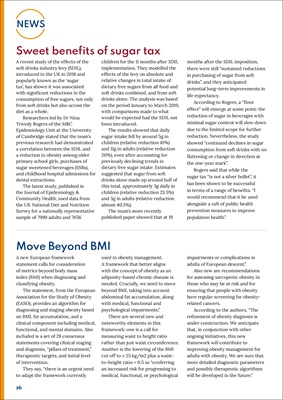
16
NEWS
Sweet benefits of sugar tax
A recent study of the effects of the
soft drinks industry levy (SDIL),
introduced in the UK in 2018 and
popularly known as the 'sugar
tax', has shown it was associated
with significant reductions in the
consumption of free sugars, not only
from soft drinks but also across the
diet as a whole.
Researchers led by Dr Nina
Trivedy Rogers of the MRC
Epidemiology Unit at the University
of Cambridge stated that the team's
previous research had demonstrated
a correlation between the SDIL and
a reduction in obesity among older
primary school girls, purchases of
sugar sweetened beverages (SSBs),
and childhood hospital admissions for
dental extractions.
The latest study, published in
the Journal of Epidemiology &
Community Health, used data from
the UK National Diet and Nutrition
Survey for a nationally representative
sample of 7999 adults and 7656
children for the 11 months after SDIL
implementation. They modelled the
effects of the levy on absolute and
relative changes in total intake of
dietary free sugars from all food and
soft drinks combined, and from soft
drinks alone. The analysis was based
on the period January to March 2019,
with comparisons made to what
would be expected had the SDIL not
been introduced.
The results showed that daily
sugar intake fell by around 5g in
children (relative reduction 10%)
and 11g in adults (relative reduction
20%), even after accounting for
previously declining trends in
dietary free sugar intake. Estimates
suggested that sugar from soft
drinks alone made up around half of
this total, approximately 3g daily in
children (relative reduction 23.5%)
and 5g in adults (relative reduction
almost 40.5%).
The team's more recently
published paper showed that at 19
months after the SDIL imposition,
there were still "sustained reductions
in purchasing of sugar from soft
drinks", and they anticipated
potential long-term improvements in
life expectancy.
According to Rogers, a "floor
effect" will emerge at some point: the
reduction of sugar in beverages with
minimal sugar content will slow down
due to the limited scope for further
reduction. Nevertheless, the study
showed "continued declines in sugar
consumption from soft drinks with no
flattening or change in direction at
the one-year mark".
Rogers said that while the
sugar tax "is not a silver bullet", it
has been shown to be successful
in terms of a range of benefits. "I
would recommend that it be used
alongside a raft of public health
prevention measures to improve
population health."
Move Beyond BMI
A new European framework
statement calls for consideration
of metrics beyond body mass
index (BMI) when diagnosing and
classifying obesity.
The statement, from the European
Association for the Study of Obesity
(EASO), provides an algorithm for
diagnosing and staging obesity based
on BMI, fat accumulation, and a
clinical component including medical,
functional, and mental domains. Also
included is a set of 28 consensus
statements covering clinical staging
and diagnosis, "pillars of treatment,"
therapeutic targets, and initial level
of intervention.
They say, "there is an urgent need
to adapt the framework currently
used in obesity management.
A framework that better aligns
with the concept of obesity as an
adiposity-based chronic disease is
needed. Crucially, we need to move
beyond BMI, taking into account
abdominal fat accumulation, along
with medical, functional and
psychological impairments."
There are several new and
noteworthy elements in this
framework: one is a call for
measuring waist to height ratio
rather than just waist circumference.
Another is the lowering of the BMI
cut off to ≥ 25 kg/m2 plus a waistto-height
ratio > 0.5 as "conferring
an increased risk for progressing to
medical, functional, or psychological
impairments or complications in
adults of European descent."
Also new are recommendations
for assessing sarcopenic obesity in
those who may be at risk and for
ensuring that people with obesity
have regular screening for obesityrelated
cancers.
According to the authors, "The
refinement of obesity diagnosis is
under construction. We anticipate
that, in conjunction with other
ongoing initiatives, this new
framework will contribute to
improving obesity management for
adults with obesity. We are sure that
more detailed diagnostic parameters
and possibly therapeutic algorithms
will be developed in the future."